width AUDI A5 COUPE 2010 Owners Manual
[x] Cancel search | Manufacturer: AUDI, Model Year: 2010, Model line: A5 COUPE, Model: AUDI A5 COUPE 2010Pages: 360, PDF Size: 84.39 MB
Page 139 of 360
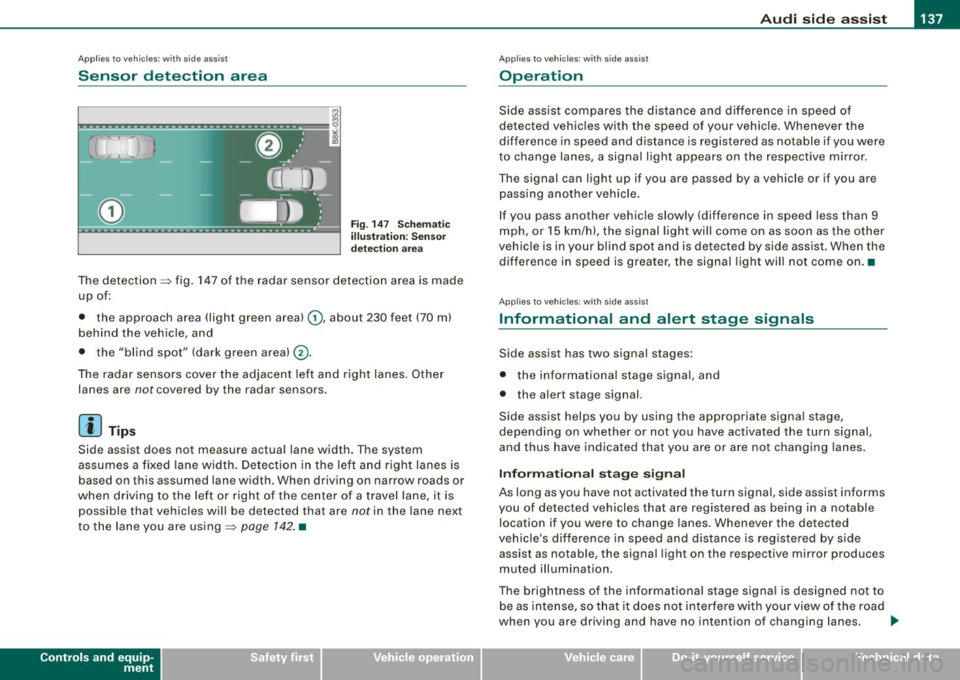
_________________________________________________ A _u_ d_ i _s _ i_d _e _ a_s_ s_ i_ s _t __ !II
Ap plies to vehi cle s: w ith side a ssist
Sensor detection area
Fi g. 14 7 Sc hem atic
illu stra tion: Senso r
d etec tion area
The detection => fig . 147 of the radar sensor detection area is made
up of:
• the approach area (light green area)
0, about 230 feet (70 m)
behind the vehic le, and
• the "blind spot" (dark green areal@.
The radar sensors cover the adjacent left and right lanes. Other
lanes are
not covered by the radar sensors.
[ i ] Tip s
Side assist does not measure actual lane width. The system
assumes a fixed lane width . Detection in the left and right lanes is
based on this assumed lane width . When driving on narrow roads or
when driving to the left or right of the center of a trave l lane, it is
possible that vehicles will be detected that are
not in the lane next
t o the lane you are using=>
page 142. •
Controls and equip
ment
Ap plies to veh ic les : wi th side ass ist
Operation
Side assist compares the distance and difference in speed of
detected vehic les with the speed of your vehic le. Whenever the
difference in speed a nd distance is registered as notable if you were
to change lanes , a signal light appears on the respective mirror .
The signal can light up if you are passed by a vehicle or if you are passing another vehicle.
If you pass another vehicle slow ly (difference in speed less than 9
mph, or
15 km/h), the signal light wil l come on as soon as the o ther
vehic le is in your b lind spot and is detected by side assist. When the
difference in speed is greater, the signal light will not come on .•
Ap plies to vehi cles : with si de assi st
Informational and alert stage signals
Side assist has two signal stages:
• t he informational stage s igna l, and
• the alert stage signal.
Side assist helps you by using the appropriate signa l stage,
depending on whether or not you have activated the tu rn signal,
and thus have indicated that you are or are not changing lanes .
Infor mation al stage signal
As long as you have not activated the turn signa l, side assist informs
you of detected vehicles that are registered as being in a notable location if you were to change lanes. Whenever the detected
vehicle's difference in speed and distance is registered by side assist as notable, the signal light on the respective mirror produces
muted illumination.
The brightness of the informational stage signa l is designed not to
be as intense, so that it does not interfere with your view of the road
when you are driving and have no intention of changing lanes. .,
I • •
Page 143 of 360
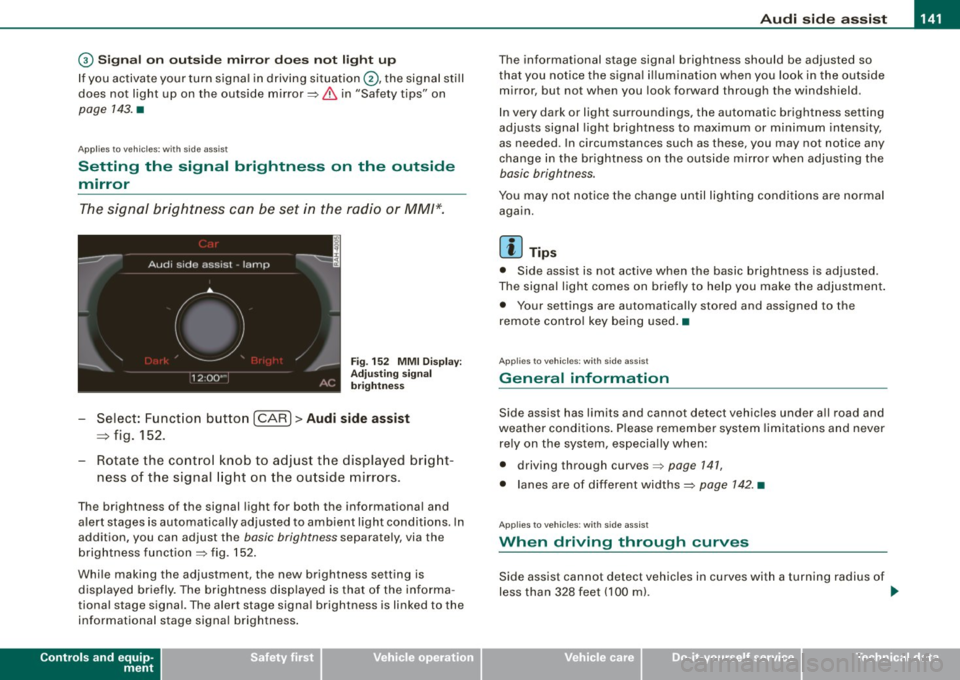
___________________________________________________ A_ u _ d_i_ s_ id_ e_ a _ s_s _ i_s _t __ llllll
© Signal on outside mirror does not light up
If you activate your turn signal in driving situation @, the signal still
does not light up on the outside mirror=>
& in "Safety tips" on
page 143. •
Applies t o vehicles: with side assist
Setting the signal brightness on the outside
mirror
The signal brightness can be set in the radio or MM/*.
Fig. 152 MMI Display:
Adjusting sign al
brigh tness
- Select: Function button [CARI> Audi side assist
=> fig. 152.
- Rotate the cont ro l knob to adjust the displayed bright-
ness of the signal light on the outside mirrors .
The brightness of the signal light for both the informationa l and
alert stages is automatica lly adjusted to ambient light conditions. In
addition, you can adjust the
basic brightness separately, via the
brightness function
=> fig . 152.
While making the adjustment, the new brightness setting is
displayed briefly. The brightness displayed is that of the informa
tional stage signal. The alert stage signa l brightness is linked to the
informational stage signal brightness .
Controls and equip
ment
The informational stage signal brightness should be adjusted so
that you notice the signa l illumination when you look in the outside
mirror, but not when you look forward through the windshield.
In very dark or light surroundings, the automatic brightness setting
adjusts signal ligh t brightness to maximum or minimum intensity,
as needed . In circumstances such as these, you may not notice any
change in the brigh tness on the outside mirror when adjusting the
basic brightness.
You may not notice the change until lighting conditions are normal
again.
[ i ] Tips
• Side assist is not active when the basic brightness is adjusted.
The signal light comes on briefly to help you make the adjustment .
• Your settings are automatically stored and assigned to the
remote control key being used.•
Applies to veh ic les: with s ide ass ist
General information
Side assist has limits and cannot detect vehicles under a ll road and
weather conditions . Please remember system limitat ions and never
re ly on the system, especially when:
• driving through curves=>
page 141,
• lanes are of different widths=> page 142. •
Applies to veh ic les : with s ide ass ist
When driving through curves
Side assist cannot detect vehic les in curves with a turning radius of
less than 328 feet (100 ml. .,,
I • •
Page 144 of 360
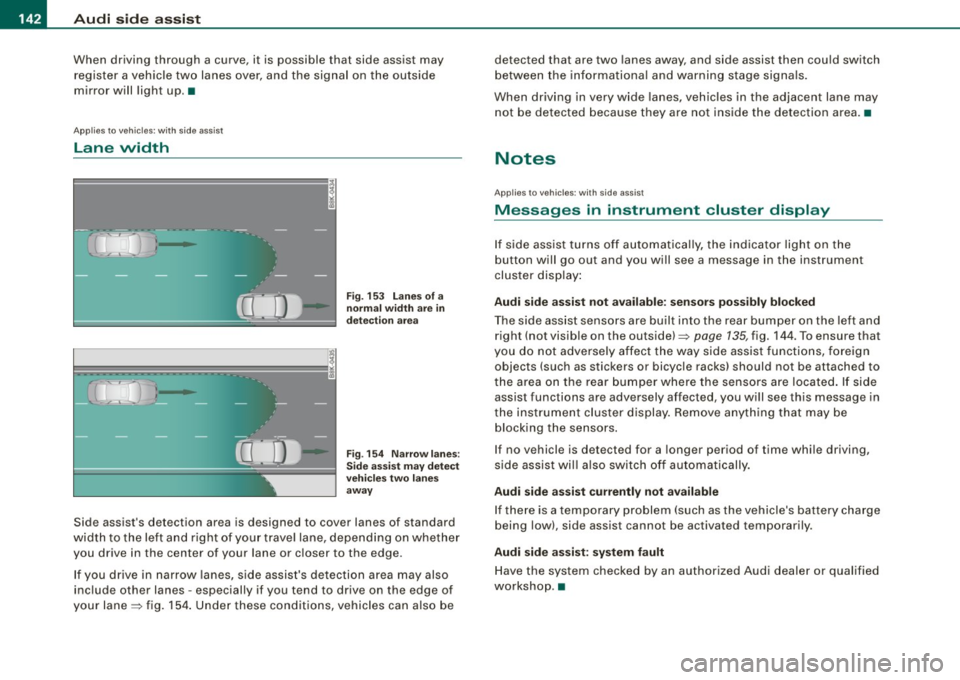
• .___A_ u_ d_ i_s_ i_ d _e_ a_ s_ s_is _ t __________________________________________________ _
When driving through a curve, it is possible that side assist may
register a vehicle two lanes over, and the signal on the outside
mirror will light up.•
Applies to veh icles: with side assist
Lane width
Fig. 153 Lanes of a
normal width are in
detection area
Fig. 154 Narrow lanes :
Side assist may detect
vehicles two lanes
away
Side assist's detection area is designed to cover lanes of standard
width to the left and right of your travel lane, depending on whether
you drive in the center of your lane or closer to the edge.
If you drive in narrow lanes, side assist's detection area may also
include other lanes -especially if you tend to drive on the edge of
your lane=> fig. 154. Under these conditions, vehicles can also be detected that are two
lanes away, and side assist then could switch
between the informational and warning stage signals.
When driving in very wide lanes, vehicles in the adjacent lane may
not be detected because they are not inside the detection area. •
Notes
Applies to vehicles: with side assist
Messages in instrument cluster display
If side assist turns off automatically, the indicator light on the
button will go out and you will see a message in the instrument
cluster display:
Audi side assist not available : sensors possibly blocked
The side assist sensors are built into the rear bumper on the left and
right (not visible on the outside)=? page 135, fig, 144. To ensure that
you do not adversely affect the way side assist functions, foreign
objects (such as stickers or bicycle racks) should not be attached to
the area on the rear bumper where the sensors are located. If side
assist functions are adversely affected, you will see this message in
the instrument cluster display. Remove anything that may be
blocking the sensors.
I f no vehicle is detected for a longer period of time while driving,
side assist will also switch off automatically.
Audi side assist currently not available
If there is a temporary problem (such as the vehicle's battery charge
being low), side assist cannot be activated temporarily.
Audi side assist: system fault
Have the system checked by an authorized Audi dealer or qualified
workshop. •
Page 145 of 360

___________________________________________________ A_ u _ d_i_ s---- id ___ e....:. a:..:s :..:s :..: i..::s :..:t __ ftllll
Ap plies to vehi cle s: w ith side a ssist
Safety tips
The side ass ist detec tion may be l imited w hen d riv ing ar ound
narrow street corners, on hi lly streets, and under poor weather
co nd ition s.
I t is possible that the radar sensors may also detect other objects,
suc h as high o r stagge red guardra ils .
S ide ass ist does not meas ure ac tua l la ne widt h. The syste m
assumes a fi xed lane width . Detection in the left and right lanes is
b ased on this assu med lan e wid th. Whe n driv in g o n na rro w roa ds or
when driving to the left or r ight of the c enter of a trave l lane, it is
po ssi ble that ve hic le s will be detec te d tha t are
no t in th e lane next
to the lane you are using .
& WARNING
• Improper reliance on the side assist system can cause colli
sions and serious personal injury:
-Never rely only on side assist when changing lanes .
- Always check rear view mirrors to make sure that it is safe to change lanes .
• Side assist cannot detect all vehicles under all condition s
danger of accident!
• Side a ssist cannot detect vehicles in time to alert you when
they approach from behind at very high speed , or fall drop back
very quickly.
• The radar sensor's
vision can be redu ced or entirely blocked by
rain, snow , and heavy spray . This can result in side assi st not
adequately detecting veh icles or , in some cases , not detecting
them at all . Always keep an eye on the direction you are traveling
and the relevant area around the vehicle.
Controls and equip
ment
& WARNING (continued )
• Please note that side assist indicates there are approaching
vehicles, or vehicles in your blind spot , only after your vehicle has
reached a driving speed of at least 19 mph 130 km/h).
• Side assist signal does not work around tight corners (turning
radius less than 328 feet, or 100 ml. • S ide assist is no replacement for the driver' s full attention. The
driver alone is responsible for lane changes and similar driving
maneuvers . Always keep an eye on the direction you are traveling
and the relevant area around the vehicle .
(D Note
To ensu re that side assist is not adversely affected , you sho uld not
b lock the area on the rear bumper where t he radar s ensors are
located with foreign objects (such as with stickers or bicycle racks) .
[ i ] Tips
If the positions of the radar sensors have been changed as a result
o f a re ar end -c olli sio n, for i nsta nce, have s ide ass ist c hecked by a n
authorized Audi dea ler for safety reasons .•
I • •
Page 290 of 360

-~_T_ ir_e_ s_ a_ n_d _ w_ h_ e_e _l_s _________________________________________________ _
& WARNING (continued)
crashes and serious personal injuries . Have worn or damaged tires
replaced immediately.
• Tires age even if they are not being used and can fail suddenly,
especially at high speeds. Tires that are more than 6 years old can
only be used in an emergency and then with special care and at
low speed.
Glossary of tire and loading terminology
Accessory weight
means the combined weight (in excess of those standard items
which may be replaced) of automatic transmission, power steering,
power brakes, power windows, power seats, radio, and heater, to
the extent that these items are available as factory-installed equip
ment (whether installed or not).
Aspect ratio means the ratio of the height to the width of the tire in percent.
Numb ers of 55 or lower indicate a low sidewall for improved
steering response and better overall handling on dry pavement.
Bead
means the part of the tire that is made of steel wires, wrapped or reinforced by ply cords and that is shaped to fit the rim.
Bead separation means a breakdown of the bond between components in the bead.
Cord
means the strands forming the plies in the tire.
& WARNING (continued)
• Never mount used tires on your vehicle if you are not sure of
their "previous history." Old used tires may have been damaged
even though the damage cannot be seen that can lead to sudden
tire failure and loss of vehicle control.
• If you notice unusual vibration or if the vehicle pulls to one side
when driving, always stop as soon as it is safe to do so and check
the wheels and tires for damage . •
Cold tire inflation pressure
means the tire pressure recommended by the vehicle manufacturer
for a tire of a designated size that has not been driven for more than
a couple of miles (kilometers) at low speeds in the three hour period
before the tire pressure is measured or adjusted.
Curb weight means the weight of a motor vehicle with standard equipment
including the maximum capacity of fuel, oil, and coolant, air condi
tioning and additional weight of optional equipment.
Extra load tire
means a tire design to operate at higher loads and at higher infla
tion pressures than the corresponding standard tire. Extra load tires
may be identified as "XL",
"xi", "EXTRA LOAD", or "RF" on the side
wall.
Gross Axle Weight Rating ("GAWR")
means the load-carrying capacity of a single axle system, measured
at the tire -ground interfaces.
Gross Vehicle Weight Rating ("GVWR"l
means the maximum total loaded weight of the vehicle.
Page 291 of 360

________________________________________________ T_ i _r_e _s_ a_n_ d_ w_ h_ e_e _ l_s __ lR
•
Groove
means the space between two adjacent tread ribs.
L oad ra ting (code)
means the maximum load that a tire is rated to carry for a given
inflation pressure. You may not find this information on all tires
because it is not required by law.
M ax im um l oad ra tin g
means the load rating for a tire at the maximum permissib le infla
tion pressure for that tire.
Ma ximum l oaded v ehi cle weigh t
means the sum of:
(a) Curb weight
(b) Accessory weight
(c) Vehic le capacity weight, and
(ct) Production options weight
M ax im um (p er mi ssibl e) infl ati on pr essur e
means the maximum cold inflation pressure to wh ich a tire may be
inflated. Also ca lled "maximum inflation pressure."
Normal occ upa nt wei ght
means 150 lbs. (68 kilograms) times the number of occupants
seated in the vehicle up to the to tal seating capacity of your vehicle.
O ccupant di stributi on
means distribution of occupants in a vehicle .
Outer di am eter
means the overall diameter of an inflated new tire.
O ve rall wi dth
means the linear distance between the exteriors of the sidewa lls of
an inflated tire, includ ing elevations due to labeling, decorations, or
protective bands or ribs.
Pl y
means a layer of rubber -coated para lle l cords.
P rodu ction opt io ns wei ght
means the combined weight of those installed regular production
options weighing over 5 lbs . (2.3 kg) in excess of those standard
i t ems wh ich they replace, not previously considered in curb weigh t
or accessory weight, including heavy duty brakes, ride levelers, roof
rack, heavy duty battery, and specia l trim .
Radi al p ly tire
means a pneumatic tire in which the ply cords that extend to the
beads are laid at substantially 90 degrees to the centerline of the
tread .
Reco mm ended infl ati on pr essu re
see => page 288, "Cold tire inflation pressure".
Rein force d tir e
means a tire des ign to operate at higher loads and at higher infla
tion pressures than the corresponding standard tire. Reinforced
t ires may be identi fied as "XL", "x i", "EXTRA LOAD", or "RF" on the
sidewall.
R im
means a metal support for a tire or a tire and tube assembly upon
wh ich the t ire beads are seated.
Rim di amet er
means nominal diameter of the bead seat. If you change your whee l
size, you wi ll have to purchase new tires to match the new rim diam
eter .
Rim siz e de sig nation
means rim diameter and width.
Rim wid th
means nominal distance between rim flanges.
Vehicle care I t •
Page 301 of 360
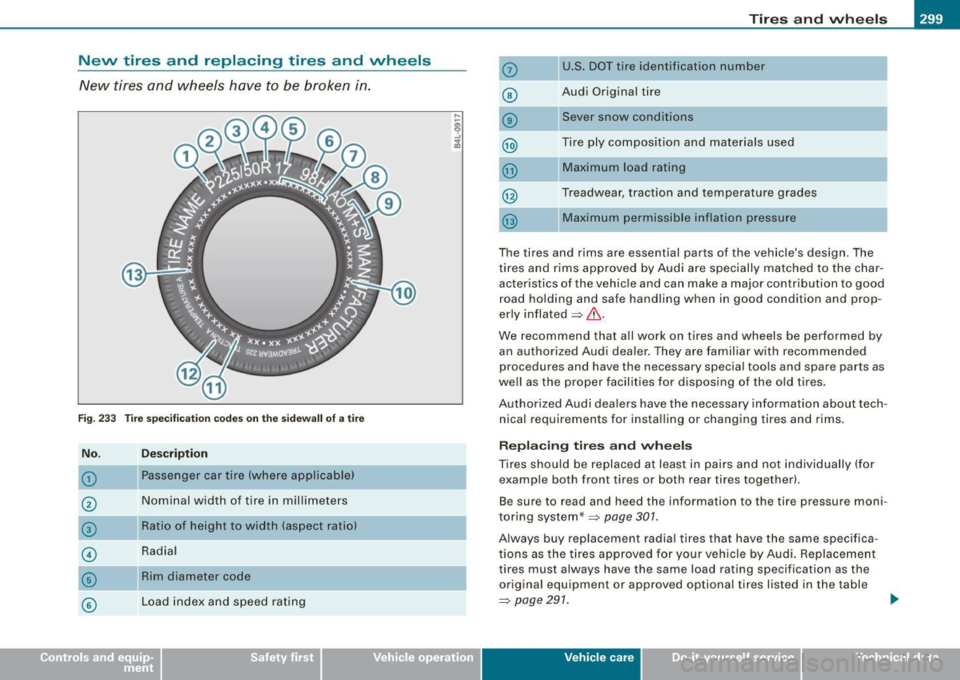
__________________________________________________ T_ ir_e _ s_ a_ n _ d_ w_ h_ e_ e_ls _ ____. ffllll
New tires and replacing tires and wheels
New tires and wheels have to be broken in.
Fig. 233 Tire specification codes on the sidewall of a tire
No.
G)
@
©
©
©
©
Description
Passenger car tire (where applicable)
Nominal width of tire in millimeters
Ratio of height to width (aspect ratio)
Radial
Rim diameter code
Load index and speed rating
0
©
U.S. DOT tire identificat ion number
Audi Original tire
Sever snow condit ions
Tire ply composition and materials used
@ Maximum load rating
@ Treadwear, traction and temperature grades
@ Maximum permissible inflation pressure
The tires and rims are essential parts of the vehicle's design . The
tires and rims approved by Audi are specially matched to the char
acteristics of the vehicle and can make a major contribution to good
road holding and safe handling when in good condition and prop
erly inflated
=> & .
We recommend that all work on tires and wheels be performed by
an authorized Audi dealer. They are familiar with recommended
procedures and have the necessary special tools and spare parts as
well as the proper facilities for disposing of the old tires.
Authorized Audi dealers have the necessary information about tech
nical requirements for installing or changing tires and rims.
Replacing tires and wheels
Tires should be replaced at least in pairs and not individually (for
example both front tires or both rear tires together).
Be sure to read and heed the information to the tire pressure moni
toring system* =>
page 301.
Always buy replacement radial tires that have the same specifica
tions as the tires approved for your vehicle by Audi. Replacement
tires must always have the same load rating specification as the
original equipment or approved optional tires listed in the table
=> page 291. ~
Vehic le care I I irechnical data
Page 302 of 360
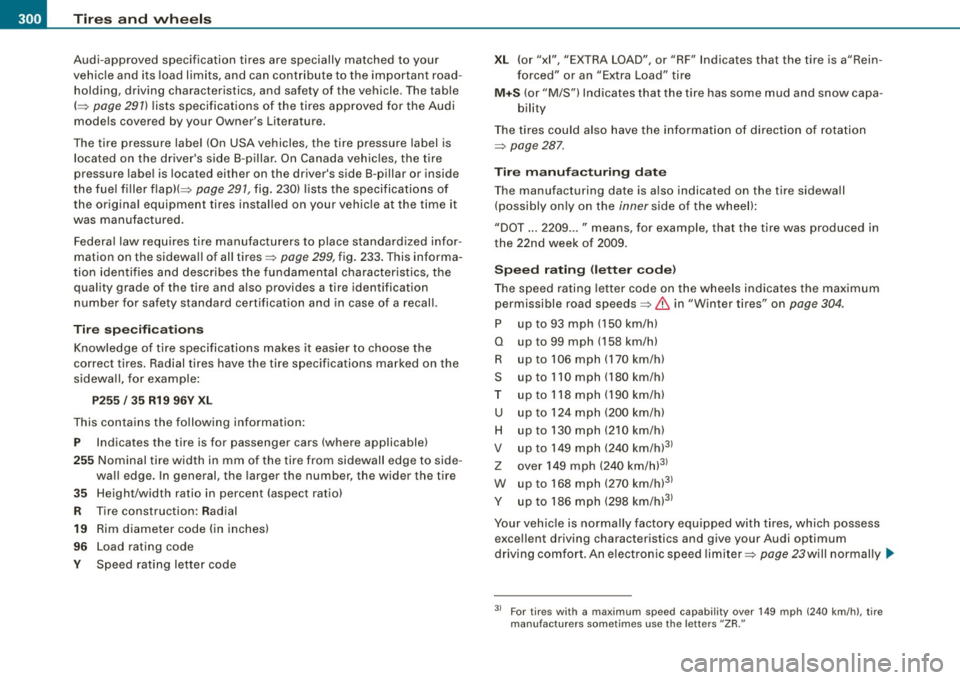
-~_T_ ir_e_ s_ a_ n_d _ w_ h_ e_e _l_s _________________________________________________ _
Audi-approved specification tires are specially matched to your
vehicle and its load limits, and can contribute to the important road
holding, driving characteristics, and safety of the vehicle . The table
(~ page 291) lists specifications of the tires approved for the Audi
models covered by your Owner's Literature.
The tire pressure label (On USA vehicles, the tire pressure label is located on the driver's side 8 -p illar. On Canada vehicles, the tire
pressure label is located either on the driver's side B-pillar or inside
t he fue l filler flap)( ~
page 291, fig. 230) lists the specifications of
the origina l equipment tires instal led on your vehicle at the time it
was manufactured.
Federal law requires tire manufacturers to place standardized infor
mation on the sidewa ll of all tires~
page 299, fig. 233 . This informa
tion identif ies and describes the fundamenta l characteristics, the
quality grade of the tire and a lso provides a tire identification
number for safety standard certificat ion and in case of a recall.
Tir e s pec ifica tio ns
Knowledge of tire specifications makes it easier to choose the
correct tires . Radial tires have the tire specifications marked on the
sidewa ll, for example:
P255 / 3 5 R19 96V XL
This contains the fo llowing information:
P Indicates the tire is for passenger cars (where applicable)
25 5 Nominal tire width in mm of the tire from sidewall edge to side -
wa ll edge. In general, the larger the number, the wider the t ire
3 5 Height/width ratio in percent (aspect ratio)
R T ire construction: Radial
19 Rim diameter code (in inches)
96 Load rating code
Y Speed rating letter code
XL (or "xi", "EXTRA LOAD", or "RF" Indicates that the tire is a"Rein
forced" or an "Extra Load" tire
M+ S (or "M/S") Indicates that the t ire has some mud and snow capa-
bility
The ti res cou ld also have the information of direction of rotation
~ page 287.
T ire m anuf acturing d ate
The manufacturing date is a lso indicated on the tire sidewa ll
(possibly on ly on the
inner side of the wheel) :
"DOT ... 2209 ... " means, for example, that the tire was produced in
the 22nd week of 2009.
S pe ed ra ting
permissible road speeds~
& in "Winter tires" on page 304.
P up to 93 mph (150 km/h)
Q up to 99 mph ( 158 km/h)
R up to 106 mph (170 km/h)
s up to 110 mph (180 km/hl
T up
to 118 mph (190 km/h)
u up to 124 mph (200 km/h)
H up to 130 mph (210 km/h)
V up to 149 mph (240
km/hJ31
z over 149 mph (240 km/h)31
w up to 168 mph (270 km/h)31
y up to 186 mph (298 km/hJ31
Your vehicle is norma lly factory equipped w ith tires, which possess
excellent driving characteristics and give your Audi optimum
driving comfort. An e lectronic speed limiter ~
page 23will normally .,,_
31 For tires with a maximum speed capability over 149 mph (240 km/h), t ire
manufacturers sometimes use the letters "ZR."
Page 305 of 360

__________________________________________________ T_ ir_e_ s_ a_ n_d _ w_ h_ e _ e_l_s __ lllll
•
• Never drive without the valve stem cap. The valves could get
damaged.
• If the sensors must be replaced, then the valve must also be
replaced at the same time.
For the sake of the environment
Dispose of old tires in accordance with the local requirements. •
Uniform tire quality grading
• Tread wear
• Traction AA A B C
• Temperature A B C
Quality grades can be found where applicable on the tire side wall
between tread shoulder and maximum section width~
page 299,
fig. 233.
For example: Tread wear 200, Traction AA, Temperature A.
All passenger car tires must conform to Federal Safety Require ments in addition to these grades .
Tread wear
The
tread wear grade is a comparative rating based on the wear rate
of the tire when tested under controlled conditions on a specified
government test course.
For example, a tire graded 150 would wear one and one half (1 1/2)
times as well on the government course as a tire graded 100.
The relative performance of tires depends upon the actual condi
tions of their use, however , and may depart significantly from the
norm due to variations in driving habits, service practices and differ
ences in road characteristics and climate. Traction
The
traction grades, from
highest to lowest, are AA, A, Band C.
Those grades represent the tire's ability to stop on wet pavement as measured under controlled conditions on specified government
test surfaces of asphalt and concrete. A tire marked C may have
poor traction performance~& .
Temperature
The
temperature grades are A (the highest), B, and C, representing
the tire's resistance to the generation of heat and its ability to dissi
pate heat when tested under controlled conditions on a specified
indoor laboratory test wheel.
Sustained high temperature can cause the material of the tire to
degenerate and reduce tire life, and excessive temperature can lead
to sudden tire failure=>&.
The grade C corresponds to a level of performance which all
passenger car tires must meet under the Federal Motor Vehicle
Safety Standard No. 109. Grades Band A represent higher levels of
performance on the laboratory test wheel than the minimum
required by law .
& WARNING
The traction grade assigned to this tire is based on straight-ahead
braking traction tests, and does not include acceleration,
cornering, hydroplaning or peak traction characteristics .
& WARNING
The temperature grade for this tire is established for a tire that is
properly inflated and not overloaded. Excessive speed, underinfla
tion, or excessive loading, either separately or in combination, can
cause heat buildup and possible tire failure. •
Vehicle care
I t •
Page 308 of 360
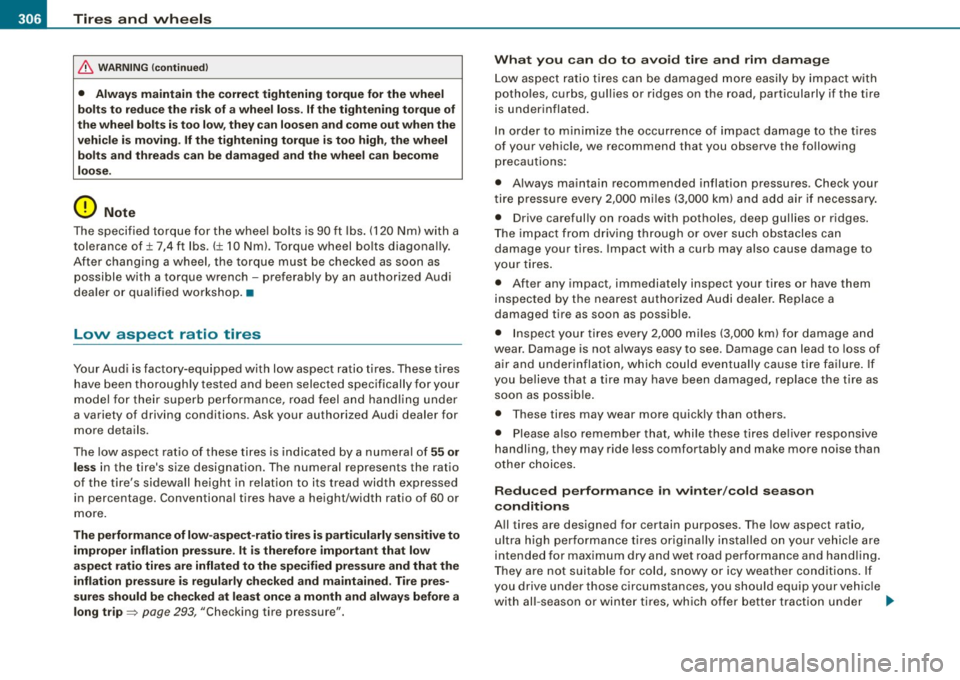
-~_T_ ir_e_ s_ a_ n_d _ w_ h_ e_e _l_s _________________________________________________ _
& WARN ING (continued )
• Always maintain the correct tightening torque for the wheel
bolt s to reduce the risk of a wheel loss . If the tightening torque of
the wheel bolts is too low, they can loo sen and come out when the
vehicle is moving . If the tightening torque is too high , the wheel
bolts and threads can be d amaged and the wheel can be come
loose .
0 Note
The specified torque for the whee l bo lts is 90 ft lbs . (120 Nm) with a
tolerance of ± 7,4 ft lbs .(± 10 Nml. Torque wheel bo lts diagona lly.
Af te r cha ng ing a whe el, the torque mus t be checked as so on as
possible with a torque wrench -preferably by an authorized Audi
dea ler o r qua lified w orksh op.•
Low as pect rat io tires
Yo ur Audi is fac tory-equipped with l ow aspec t ratio tires . Thes e tires
have been thorough ly tested and been selected specifically for your
m odel f or their superb pe rformance, r oad feel and hand ling under
a variety of driving conditions . Ask your authorized Audi dealer for
m ore deta ils .
T he low aspec t rat io of these ti res is indicated by a nu meral o f
55 or
less
in the tire's si ze designation. The numeral represents the ratio
o f the tire's sid ewa ll heig ht in relat ion t o it s tread w idth express ed
in percentage. Conventiona l tires have a height/width ratio of 60 or
m ore .
The performance of low -aspect -ratio tires is particularly sensitive to
improper inflation pressure . It is therefore important that low
aspect ratio tires are inflated to the specified pres sure and that the
i nflation pressure is regularly checked and maintained . Tire pres
sures should be checked at least once a month and alway s before a
long trip ~
page 293, "Checking tire pr essure".
What you can do to avoid tire and rim damage
Lo w aspec t r ati o t ir es ca n be da maged more easi ly by impact wi th
potholes, curbs, gullies or ridges on the road, particularly if the tire
i s un derinflate d.
In order to minimize t he occurrence o f impac t damage to the t ires
of your vehicle , we recommend that you observe the following
p recau tions:
• Always ma intain recommended inflation pressures . Check your
t ire pressure every 2,000 miles (3,000 k m) and ad d air i f neces sa ry .
• D rive careful ly on roads with potholes, deep gullies or ridges.
Th e impa ct from driving throug h or over such o bstacles can
damage your tires. Impact with a curb may also cause damage to
you r ti res .
• After any impact, immediately inspect your tires or have them
inspected by the neares t autho rize d Audi deale r. R eplace a
damaged tire as soon as possib le.
• I nspect you r tir es eve ry 2 ,0 0 0 m iles (3 ,000 k m) for damage a nd
wear. Damage is not always easy to see. Damage can lead to loss of
a ir and under infla tion , wh ic h co ul d even tually cause tire fa ilu re . If
you believe t hat a tire may have been damaged , rep lace the tire as
soon as p ossi ble.
• T hese tires may wear more quickly than others .
• Please also re member th at, wh ile t hese tir es de liver respo nsive
handling, they may ride less comfortably and make more noise than
ot her c hoic es.
Reduced performance in winter /cold season
conditions
A ll tires are designed for certain purposes. The low aspect ra tio,
u ltra high per form ance t ires or ig ina lly ins tal led on yo ur ve hicle are
intended for maximum dry and wet road performance and hand ling.
Th ey a re not su itab le f or cold, sn owy or ic y weathe r co nd ition s. If
you drive under those c ircumstances, you should equip your vehic le
wi th all -season o r wi nter ti re s, w hic h offe r bett er trac tion und er
ti-